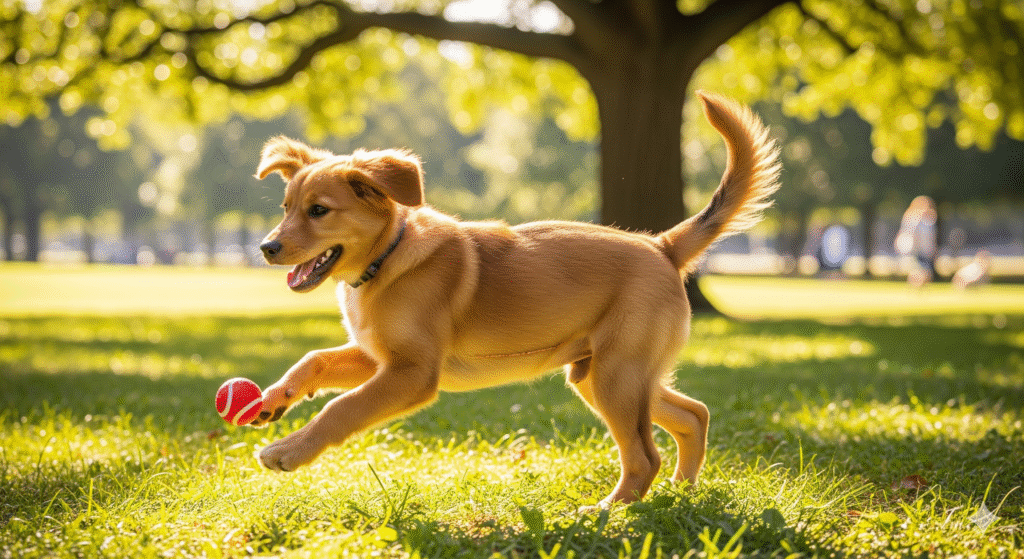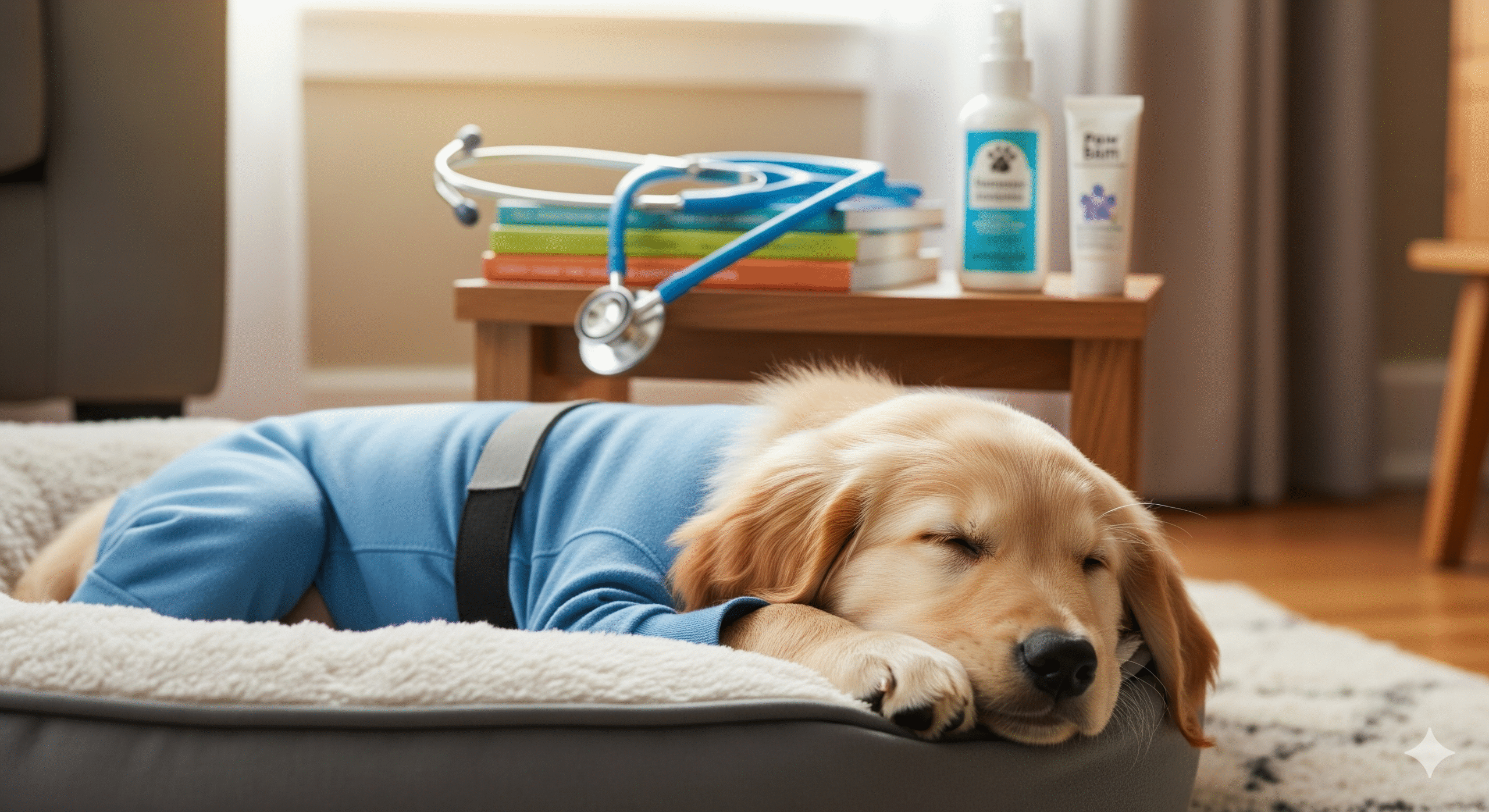Scheduling your puppy’s spay or neuter surgery is a responsible decision for their long-term health, but the post-operative recovery period can feel daunting for any pet owner. Your lively, energetic puppy will suddenly need to be calm and restricted, and knowing how to care for them properly is crucial for preventing complications. A successful recovery hinges on knowing exactly what to expect and how to manage each step of the process.
This comprehensive guide will walk you through the entire recovery timeline, from the moment you pick them up from the vet to the day they get their clean bill of health. We’ll provide vet-approved advice to make this process as smooth and stress-free as possible for both you and your pup.
Here’s what we’ll cover:
✔️ The first 24 hours post-surgery: what’s normal and what’s not
✔️ A day-by-day recovery timeline and healing stages
✔️ How to properly use an E-collar (cone) and comfortable alternatives
✔️ Step-by-step instructions for checking the incision site
✔️ Activity restrictions and how to enforce them with a energetic puppy
✔️ Red flags: When to call the vet immediately
Let’s prepare you for a seamless and successful recovery journey.
Picking Up Your Puppy: The First Steps
When you collect your puppy from the clinic, they will likely still be groggy from anesthesia.
- They may be disoriented, wobbly, or whiny. This is normal.
- You will receive post-operative instructions. Listen carefully and ask questions.
- Ensure you have any prescribed pain medication and understand the dosage schedule.
- Get them home quickly and comfortably. Have a friend drive so you can hold their carrier steady.
- Prepare a quiet, warm, and confined space at home with easy access to water.
The Recovery Timeline: Day-by-Day Expectations 📅
Day 1: The Groggy Day 😴
- Behavior: Your puppy will sleep most of the day. They may be less interested in food and water. Offer a small, bland meal (like boiled chicken and rice) a few hours after getting home.
- Incision: The site will look clean and the edges will be closed. There may be slight redness or minor bruising.
- Your Job: Let them rest. Keep them confined to a small, quiet area like a crate or puppy-proofed bathroom.
Days 2-3: The “Feeling Better” Deception 💪
- Behavior: Energy levels start to return. This is the most dangerous period because your puppy will feel better but is not healed. They will be tempted to run, jump, and play.
- Incision: Bruising might be more apparent (yellow, green, purple shades). This is normal. It should not be swollen, bleeding, or oozing.
- Your Job: Strict enforced rest is critical. This is when you must be most vigilant about using a cone and limiting activity.
Days 4-7: The Healing Zone ✨
- Behavior: Your puppy is now adapting to the “new normal” of restricted activity.
- Incision: Bruising fades. A scab will form over the incision. The skin might feel slightly bumpy as internal stitches do their work.
- Your Job: Continue strict confinement and cone use. The incision may start to itch, making the cone even more important.
Days 7-14: The Home Stretch 🏁
- Behavior: Your puppy is probably bored and restless. Mental stimulation is key.
- Incision: The scab may start to fall off. The skin should look closed, pink, and healthy.
- Your Job: Keep up the restrictions until your vet gives the all-clear, usually at the 10-14 day post-op checkup.
The Cone of Shame: Your Best Friend 🎯
The Elizabethan collar (E-collar or cone) is essential. It prevents licking and chewing, which can cause infection, opened incisions, and costly emergency visits.
- It must be on at all times when you cannot directly supervise your puppy, especially overnight.
- Ensure it’s the right size: It should be long enough to extend past the nose so the puppy cannot reach their side.
- Comfortable Alternatives: If your puppy is miserable in a plastic cone, ask your vet about:
- Inflatable collars: Donut-shaped cushions that are more comfortable for sleeping.
- Recovery suits: Onesies that cover the incision site on the belly.
How to Check the Incision Site 🔍
Check the incision at least twice daily. A normal, healing incision looks like:
- Closed edges with no gaps.
- No redness that is spreading away from the incision.
- No swelling or bulges at the site.
- No discharge (blood, pus, or fluid).
- No foul odor.
Managing Activity: The Biggest Challenge 🚫
Strict rest for 10-14 days is non-negotiable. This means:
- No running, jumping, or playing.
- No stairs. Carry your puppy if necessary.
- Leash walks only for brief, 5-minute potty breaks.
- Use a crate, exercise pen, or small room for confinement.
To prevent boredom:
- Puzzle toys and stuffed Kongs to provide mental stimulation.
- Short, gentle training sessions practicing calm behaviors like “sit,” “down,” and “stay.”
- Calm cuddle time on the floor with you.
Red Flags: When to Call the Vet Immediately 🚨
Contact your vet or an emergency clinic if you notice any of the following:
- The incision opens up or any internal tissue is visible.
- Continuous bleeding or seepage from the incision.
- Excessive swelling, redness, or heat at the site.
- Pus or foul-smelling discharge.
- Your puppy is excessively licking or chewing at the incision despite the cone.
- Loss of appetite for more than 24 hours.
- Vomiting or diarrhea.
- Lethargy lasting more than 24 hours.
- Pale gums.
- Straining to urinate or defecate.
Final Checklist for a Successful Recovery ✅
☑️ Quiet recovery space is set up
☑️ E-collar is fitted and on puppy
☑️ Pain medication schedule is understood
☑️ I have puzzle toys and Kongs ready for mental stimulation
☑️ I know how to check the incision for signs of infection
☑️ I have the vet’s emergency contact information handy

Ready to Choose Your Puppy’s First Collar? Now that you understand the importance of a secure fit and a reliable tag attachment, it’s time to find the perfect one. The right collar will keep them safe and comfortable as they grow. For detailed reviews on buckle types, materials, and the security of the ID tag attachment, read our buyer’s guide: Best Puppy Collars with ID Tag Slots.






